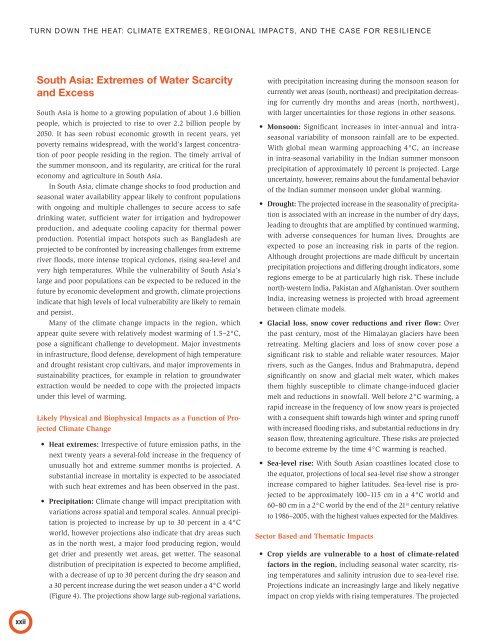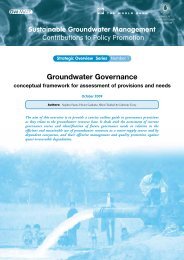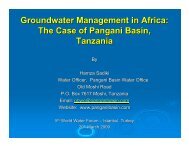You also want an ePaper? Increase the reach of your titles
YUMPU automatically turns print PDFs into web optimized ePapers that Google loves.
TURN DOWN THE HEAT: CLIMATE EXTREMES, REGIONAL IMPACTS, AND THE CASE FOR RESILIENCESouth Asia: Extremes of Water Scarcityand ExcessSouth Asia is home to a growing population of about 1.6 billionpeople, which is projected to rise to over 2.2 billion people by2050. It has seen robust economic growth in recent years, yetpoverty remains widespread, with the world’s largest concentrationof poor people residing in the region. The timely arrival ofthe summer monsoon, and its regularity, are critical for the ruraleconomy and agriculture in South Asia.In South Asia, climate change shocks to food production andseasonal water availability appear likely to confront populationswith ongoing and multiple challenges to secure access to safedrinking water, sufficient water for irrigation and hydropowerproduction, and adequate cooling capacity for thermal powerproduction. Potential impact hotspots such as Bangladesh areprojected to be confronted by increasing challenges from extremeriver floods, more intense tropical cyclones, rising sea-level andvery high temperatures. While the vulnerability of South Asia’slarge and poor populations can be expected to be reduced in thefuture by economic development and growth, climate projectionsindicate that high levels of local vulnerability are likely to remainand persist.Many of the climate change impacts in the region, whichappear quite severe with relatively modest warming of 1.5–2°C,pose a significant challenge to development. Major investmentsin infrastructure, flood defense, development of high temperatureand drought resistant crop cultivars, and major improvements insustainability practices, for example in relation to groundwaterextraction would be needed to cope with the projected impactsunder this level of warming.Likely Physical and Biophysical Impacts as a Function of ProjectedClimate Change <strong>Heat</strong> extremes: Irrespective of future emission paths, in thenext twenty years a several-fold increase in the frequency ofunusually hot and extreme summer months is projected. Asubstantial increase in mortality is expected to be associatedwith such heat extremes and has been observed in the past. Precipitation: Climate change will impact precipitation withvariations across spatial and temporal scales. Annual precipitationis projected to increase by up to 30 percent in a 4°Cworld, however projections also indicate that dry areas suchas in the north west, a major food producing region, wouldget drier and presently wet areas, get wetter. The seasonaldistribution of precipitation is expected to become amplified,with a decrease of up to 30 percent during the dry season anda 30 percent increase during the wet season under a 4°C world(Figure 4). The projections show large sub-regional variations,with precipitation increasing during the monsoon season forcurrently wet areas (south, northeast) and precipitation decreasingfor currently dry months and areas (north, northwest),with larger uncertainties for those regions in other seasons. Monsoon: Significant increases in inter-annual and intraseasonalvariability of monsoon rainfall are to be expected.With global mean warming approaching 4°C, an increasein intra-seasonal variability in the Indian summer monsoonprecipitation of approximately 10 percent is projected. Largeuncertainty, however, remains about the fundamental behaviorof the Indian summer monsoon under global warming. Drought: The projected increase in the seasonality of precipitationis associated with an increase in the number of dry days,leading to droughts that are amplified by continued warming,with adverse consequences for human lives. Droughts areexpected to pose an increasing risk in parts of the region.Although drought projections are made difficult by uncertainprecipitation projections and differing drought indicators, someregions emerge to be at particularly high risk. These includenorth-western India, Pakistan and Afghanistan. Over southernIndia, increasing wetness is projected with broad agreementbetween climate models. Glacial loss, snow cover reductions and river flow: Overthe past century, most of the Himalayan glaciers have beenretreating. Melting glaciers and loss of snow cover pose asignificant risk to stable and reliable water resources. Majorrivers, such as the Ganges, Indus and Brahmaputra, dependsignificantly on snow and glacial melt water, which makesthem highly susceptible to climate change-induced glaciermelt and reductions in snowfall. Well before 2°C warming, arapid increase in the frequency of low snow years is projectedwith a consequent shift towards high winter and spring runoffwith increased flooding risks, and substantial reductions in dryseason flow, threatening agriculture. These risks are projectedto become extreme by the time 4°C warming is reached. Sea-level rise: With South Asian coastlines located close tothe equator, projections of local sea-level rise show a strongerincrease compared to higher latitudes. Sea-level rise is projectedto be approximately 100–115 cm in a 4°C world and60–80 cm in a 2°C world by the end of the 21 st century relativeto 1986–2005, with the highest values expected for the Maldives.Sector Based and Thematic Impacts Crop yields are vulnerable to a host of climate-relatedfactors in the region, including seasonal water scarcity, risingtemperatures and salinity intrusion due to sea-level rise.Projections indicate an increasingly large and likely negativeimpact on crop yields with rising temperatures. The projected






